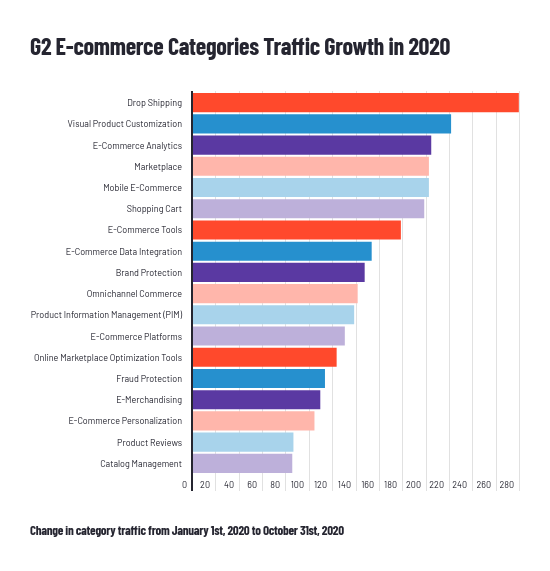This post is part of G2's 2021 digital trends series. Read more about G2’s perspective on digital transformation trends in an introduction from Michael Fauscette, G2's chief research officer and Tom Pringle, VP, market research, and additional coverage on trends identified by G2’s analysts.
Pragmatic change: the not-so-new reality of the software industry
More than 2000 years ago, the Greek philosopher Heraclitus stated that change is the only constant. Without claiming to be a philosopher, I would add that the other universal constant is resistance to change.
We tend to see change in a positive light because it’s part of life, and resisting it is perceived as a weakness. I believe that they are two sides of the same coin, and we need both. Adopting any type of change without understanding its pros and cons isn’t wise. I’m sharing these thoughts because one of the lessons I learned during the COVID-19 pandemic is that change is neither good nor bad, and resisting it can also have benefits, not only drawbacks. This applies to both our personal and professional lives.
For this reason, my predictions for 2021 will focus on pragmatic change, which I would define as a mix of technological and socio-economic advancements and wisdom (experience, knowledge, and sound judgment).
To illustrate this in practice, I will describe how it applies to two seemingly unrelated business areas: e-commerce (because we now buy online more than ever) and industrial automation (because it’s the future of manufacturing).
Consumer experience is the new battlefront in the e-commerce space
PREDICTION
E-commerce personalization is still in its early stages and will focus a lot on the users’ fear of missing out (FOMO) and basic recommendations.
For instance, cart abandonment features are used to dissuade users from leaving online stores without making a purchase. Consumers will grow tired of irrelevant recommendations and will expect engagement instead of assumptions. In other words, sellers should help buyers find what they need, which involves direct interaction with them, for example, asking consumers what they’re looking for.
This will disrupt the e-commerce software market because both sellers and buyers will put the role of technology into question. As e-commerce is getting more competitive, it will become critical to create and implement business strategies to attract and retain consumers.
Just having an online store isn’t enough anymore. The COVID-19 pandemic has accelerated the adoption of e-commerce and forced companies to sell online even though they weren’t planning to. As a result, the competition is more fierce, and companies need to focus on consumer experience as a differentiating factor. Research shows that customer satisfaction decreased in 2020 across the retail sector and even companies like Amazon experienced a decline in the American Customer Satisfaction Index (ACSI).
| Related: COVID-19 Drives E-Commerce Growth for Brick and Mortar Retailers → |
Personalization isn’t new—it started as relationship marketing, which was considered "an old idea" in the 1990s. For a long time, personalization hasn’t been very personal. Businesses used technology to segment their customers and target each segment differently. In recent practices, hyper-personalization in the sales and marketing domain aims to customize the buyer experience for each prospect or customer, using artificial intelligence (AI).
Personalization in e-commerce is similar in theory, with a few fundamental differences from B2B sales: the number of consumers is too high to create personalized experiences and the value of their purchases may be too low to justify the investment in technology and services for personalization.
Despite these challenges, G2’s E-commerce Personalization category experienced a significant increase in traffic in 2020 (104%), as the software helps to make the customer journey easier and more engaging. Even when using advanced technologies such as AI, e-commerce personalization needs a lot of data to understand buyer behavior and preferences.
Therefore, e-commerce data is now more critical than ever, both for companies and consumers. Companies need e-commerce data to better track sales and identify new opportunities, and consumers use it to make better decisions. G2’s E-commerce Data Integration category had a significant traffic increase since April 2020. We recently added new categories for e-commerce search and retail intelligence to help buyers find the best tools to manage e-commerce data.

Personalization doesn’t mean that companies should focus less on the quality of their products and services. The G2 category with the highest increase in traffic in 2020 was Drop Shipping software (279%), which shows that the post-buying experience is also essential.
| Related: Why You Need an E-Commerce Strategy and How to Create One → |
Finally, an overlooked factor of the consumer experience is the cost of the products and services, along with shipping, returns, exchanges, and so on. Furthermore, real wages actually decreased by 8.8% since 2006, which means that consumers have less money to spend. Therefore, companies need to find ways to keep costs low, and using advanced technology is one of them.
Want to learn more about E-Commerce Platforms? Explore E-Commerce Platforms products.
The road to industry 4.0 may be bumpier than we thought
PREDICTION
Industry 4.0 technology is here to stay, but it may take a while until it becomes widely used.
A pragmatic approach would be first to identify the business areas that can immediately benefit from using intelligent technology and then implement it. This is unlikely to happen in the near future, in my opinion. Instead, we expect companies to adopt a trial and error approach and hopefully learn from it.
Theoretically, COVID-19 should accelerate the adoption of industry 4.0 (the use of intelligent technology to digitally transform industrial companies), but it may, in reality, slow it down. This is mainly because remote work requires investments in software and tools that are needed immediately, as opposed to industry 4.0, which is a long-term investment.
Other factors may negatively impact the adoption of industry 4.0 technologies:
- The technologies are not mature enough to prove their efficiency. Walmart recently decided to stop using shelves scanning robots in its stores and hire 20,000 people to keep up with the 74% increase in online sales.
- Complexity is still a challenge as industry 4.0 requires a mix of software, hardware, sensors, and devices provided by multiple companies and aren’t always compatible with each other. A study of 195 German companies shows that managers are concerned about a “wide variety of possible technologies, which differ in a high diversity of its features and the possible solutions due to different providers.”
- Change management is critical because industrial companies cannot afford to rip and replace all old technology with new tools, and it takes time and effort to train employees. Empirical research shows that “implementing and using industry 4.0 requires changing the corporate culture.”
For instance, G2 reviewers shared a wide variety of challenges they’re facing when using the internet of things (IoT). The image below displays the most important challenges, such as functionality and ease of use, complexity, lack of flexibility, insufficient support and documentation, and the cost of the technology.
| Related: The Pros and Cons of Different Automation Types → |
This article describes only a tiny fraction of the tip of the industry 4.0 iceberg. Extensive education is needed to help businesses and their employees understand the long term benefits and challenges of automation.
|
How will the Fourth Industrial Revolution Impact Remote Work? |
|
How SMBs Can Benefit from Industry 4.0? |
|
How Industry 4.0 will Change Project Management |
History repeats itself
As mentioned above, personalization challenges faced by sales and marketing teams years ago will resurface in the e-commerce space. Additionally, the adoption of industry 4.0 will follow a similar trend toward cloud computing, which many companies embraced for its benefits while overlooking its drawbacks. That explains why a typical mid-sized company changed 39% of their SaaS apps between 2017 and 2018.
I hope that the COVID-19 pandemic and its negative financial impact will incentivize companies to conduct better research and compare multiple options when adopting new technology, and better manage their software spending.
Edited by Sinchana Mistry

Gabriel Gheorghiu
Gabriel’s background includes more than 15 years of experience in all aspects of business software selection and implementation. His research work has involved detailed functional analyses of software vendors from various areas such as ERP, CRM, and HCM. Gheorghiu holds a Bachelor of Arts in business administration from the Academy of Economic Studies in Bucharest (Romania), and a master's degree in territorial project management from Université Paris XII Val de Marne (France).
